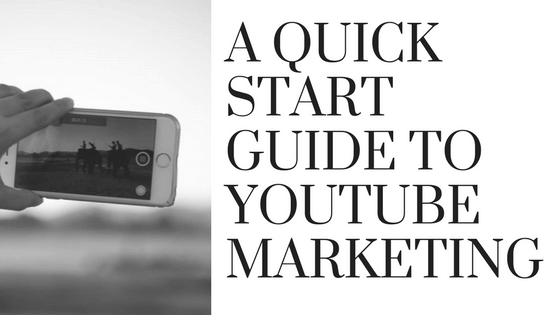A Quick Start Guide To YouTube Video Marketing

Since its launch back in 2005, YouTube has rapidly grown to become the go-to place for video content. Now, with its parent company Google, it is the second biggest search engine and attracts around 15 billion visitors every month.
An increasing amount of businesses are discovering the beauty of both video content and video ads, with businesses using video seeing around 41% more organic web traffic than those who don’t do video marketing. These companies also experience revenue growth 49% faster year-on-year.
When making the big decision to invest in video marketing, it’s important to have somewhere to host the content. YouTube is the perfect place to both boost brand awareness and help to drive more traffic to your site. If you can be clever and research thoroughly the most popular search terms in your industry, you are sure to be able to create video content that engages and creates loyal, returning customers.
Much like regular search engines, there is a certain amount of SEO that needs to be put into practice in order for your videos to show up in both Google and YouTube SERPs.
Optimising YouTube Titles, Tags and Descriptions
Optimising YouTube videos is very much like optimising normal on-site and off-site content. Keywords still play a huge part in YouTube’s algorithm, so it’s always the best place to start.
Choosing 2-3 main keywords you want both your videos and your channel to rank for. These keywords should then appear in the title of your video, its description and its tags.
Title - Keep the title as short as possible with your keywords taking precedence.
Description - Include your keywords within the first 2 lines of your description, this is what YouTube takes the most notice in when crawling the video. You should then look to include it 2-3 more times in the rest of the copy. 150 words max is more than enough for a description.
Tags - Always include your keywords in your tags, as well as your brand name. You can then tag any words that you think people may type into YouTube to find your video and adding competitor brand names can also help you appear in the ‘recommended’ sidebar, when users are watching their videos.
The Hidden Value of Subtitles
Those of us that don’t regularly use subtitles will always turn them off the videos we’re viewing. But subtitles are not only for the hard of hearing, they are also crawled by Google and YouTube search.
Actual dialogue spoken in a video can not be indexed, however, if you make sure that your dialogue is correctly transcribed into subtitles, it could help you rank that little bit higher.
When creating your video content, keep your keywords in mind and if possible, squeeze them into the narration or dialogue. That way, when you come around to inputting your subtitles, your keywords will be included in the text.
Appearing For Competitor Videos
Have you ever been watching a video on YouTube and you get a whole list of videos along the right-hand side? These videos appear here for a few different reasons, some are the most watched videos with your searched for keywords, some are targeting the channel you are watching in their video tags.
For example, the popular YouTube channel for James Corden’s Late Late Show, often targets competing late night talk show hosts in their video tags, in order to appear in the recommended videos for their channels.

Likes, Views and Sharing
The other major factor in ranking highly on YouTube is likes, views and shares. Like Google, YouTube takes user behaviours into consideration when deciding what is the most quality content for its users.
Videos with a lot of likes, views and shares will always rank higher over newer, less interacted with videos. This is where social media becomes extremely important. Without social, all of your favourite, viral YouTube videos would never have been seen and shared across the globe.
Like written content, a video should aim to solve a problem or entertain. Promotional videos can be helpful when using video for paid advertising, however, for general YouTube channel content, it can fall flat.
Your videos should either answer the questions your customers are searching for, solve their problems or entertain them. Once you start using your video content with your customers in mind, you’ll start to see why so many companies are turning to video marketing to boost revenue, brand awareness and on-site conversions.
